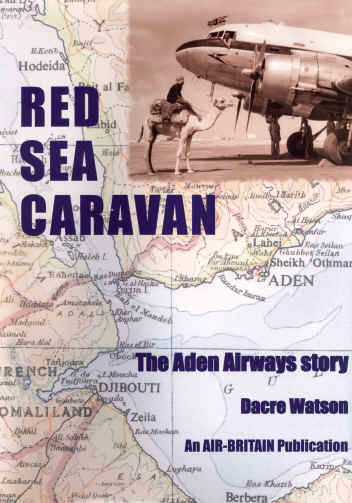| The British-Yemeni Society |

|
Book
review
Red Sea Caravan: The Aden Airways Story Red Sea Caravan: The Aden Airways Story by Dacre Watson, AirBritain (Historians) Ltd, Staplefield, West Sussex, 2008. Pp. 216. Bibliog. Appendices. Index. Many b/w & colour illus. Hb. £42. ISBN 978-085130-409-0. (Available from author at £40; £5 postage: email: dacrewatson@btinternet.com). This is a hefty work, as lavishly illustrated as any coffee table book but at the same time a serious and extensively researched history of Aden Airways. The subject matter is organised chronologically starting with BOAC’s Red Sea routes in 1948 and the birth of its offspring, Aden Airways, the following year. The ensuing chapters chart the progress of the company more or less on a chapter to a year basis up to its termination in 1967 when the British left the former colony, the ill-fated Federation of South Arabia and what remained of the original Protectorates (mostly Eastern Aden) to their fate at the hands of the National Liberation Front. As a one time ‘frequent flyer’ on Aden Airways, I was particularly interested in the details of their upcountry services. In places like Dhala or Beihan, we Political Officers were dependent on the airline’s twice weekly service to Dhala, where I was posted briefly in 1964 and for seven months in 1966. It brought our mail, goodies (and necessities) fromAden and a regular trickle of mostly official visitors. By 1966 the air route was our vital lifeline. It was hazardous to drive down to Aden with the danger of mines on the road and the threat of ambush by dissident tribesmen who by 1966 had mostly evolved into well trained and disciplined guerrillas owing allegiance to their leaders and paymasters based across the Yemen border. The increasing state of lawlessness within the faltering Federation was the context for the destruction of an Aden Airways DC3 by a bomb secreted on board, and the death of all its passengers including a colleague, Tim Goschen, on a flight from Maifa’, Wahidi, in November 1966. This was almost certainly not an act of NLF/FLOSY terrorism but the tragic outcome of a feud within the ruling establishment of theWahidi state.
Of course flights within the Protectorates were only part of Aden Airways’ network. Dacre Watson comprehensively catalogues all the regional routes with timetables which include flights to Nairobi, Asmara, Khartoum, Cairo and up the Gulf to Bahrain, flown in conjunction with other carriers such as East African Airways, Air India and Ethiopian Airlines. For the avid student of the history of civil aviation, this is a most valuable addition to the genre, while also being accessible to and entertaining for the general reader. No detail is omitted: routes and timetables, crew rosters, memories of staff members, descriptions of aircraft, details of the many remote airfields served by the company, and scores of photographs, many in colour, covering every facet of Aden Airways’ operations. The wealth of detail is staggering and is a tribute to Dacre Watson’s researches and many sources, including former pilots whose personal records and memories he was able to call upon. To anyone who served or lived in Aden and particularly in its hinterland, this book is a nostalgic reminder of our past; many old friends and long forgotten faces and places haunt its pages. I am very grateful to the author for this outstanding encyclopaedia of one of aviation’s least known backwaters to which I willingly gave six years of my life! And to the student of British colonial history in the Middle East, to the many British people who spent time, if only after the second world war, in Queen Victoria’s first imperial acquisition, this will be a volume to constantly dip into and to cherish. The price may sound a lot but I consider it well worth paying for such an unique publication. Peter Hinchliffe |
